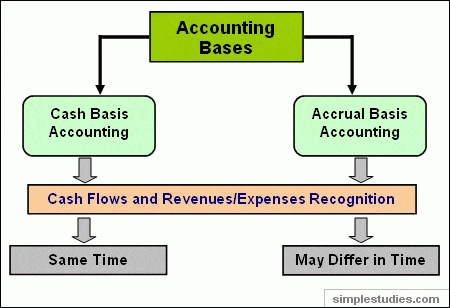Accounting for Accruals
Accruals and accrual accounting; accounts receivable and salary payable; interest receivable, interest revenue, interest payable, and interest expense.
1. Cash and accrual bases of accounting
We have discussed transactions that include direct and immediate cash flows. Cash was received in the period of earning revenues, or cash was paid in the period of incurring expenses. This is called cash accounting.
Cash (or cash-basis) accounting recognizes the effects of accounting events when cash is exchanged regardless of the time events occur. Cash-basis accounting is not in accordance with generally accepted accounting principles (GAAP).
However, more than often another situation takes place. Cash flows do not match with revenue and expense recognition. This situation falls under the accrual accounting.
Accrual (or accrual-based) accounting recognizes the effects of accounting events when such events occur regardless of the time cash is exchanged.
Accrual accounting closely relates to the definition of accounting event recognition.
Recognition is the fact of recording an event in financial records (books).
A recognition act may occur before or after cash has been collected or paid.
The term accrual means that recognition is made before cash is paid or collected.
Illustration 1: Cash accounting and accrual accounting

2. First illustration of accrual accounting
The following illustration will provide a good example of accrual accounting.
Candely Services started its operations on January 1, 20X6 when the business owner contributed $3,500 in cash. During the accounting period of 20X6 the owner, Mr. Candely, provided consulting services to customers and billed them $2,800. By the end of the accounting period he was able to collect $2,000 of $2,800 billed, leaving a balance of $800 due at the year-end. In addition, Mr. Candely incurred $1,500 liabilities for the only employee's salary. The company had paid $1,000 of this amount in 20X6, leaving a year-end balance due of $500. As of December 31, 20X6 Mr. Candely also had outstanding contracts for consulting services to be performed in 20X7 that amounted to $1,600.
The paragraph above includes the following five accounting events that we will discuss:
- The owner contributed $3,500 to the business.
- Assets obtained in 20X6 accounting period through performing services amounted to $2,800 and contracts for services to be performed in 20X7 amounted to $1,600.
- $2,000 cash was collected from the customers who had been billed for services provided.
- Salary expense for the employee amounted to $1,500.
- The employee was only paid $1,000 during 20X6 (see Event No. 4) and was to receive another $500 during 20X7.
Let us look at each of these accounting events.
